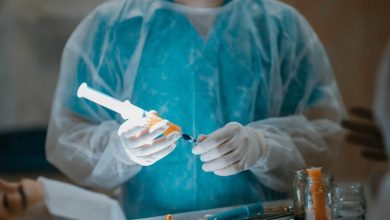Mammoplasty
Under the main heading of mammoplasty (also known as mammaplasty, breast aesthetics or mastoplasty), a number of surgical procedures are performed by aesthetic plastic and reconstructive surgeons. These procedures are intended to reshape and resize the breasts in such a way as to ensure their compliance with the ideal aesthetic standards. Mammoplasty, one of the most common plastic surgery procedures, improves the self-confidence of people and enables them to be more at peace with both themselves and the people around them.
As with breast reduction surgery, it has additional health advantages, as well. “Breast augmentation” with a silicone implant is the most common mammoplasty procedure. In this procedure, also colloquially known as “silicone surgery” or “augmentation mammoplasty”, the breast volume is increased using silicone implants, and as a result, a bra (cup) size more proportional to the patient’s body is provided.
What are the Points to Determine before Breast Augmentation Surgery?
- The shape of the silicone implant to be used is determined. The questions of whether it will be a round or a teardrop type and whether the surface will be textured or smooth are answered.
- A preliminary opinion is formed about the size of the silicone implant to be used.
- The type of the incision to be used for implant placement is determined. An incision to be made on the inframammary fold is often preferred.
- It is determined whether the silicone implant will be placed above or under the pectoral muscle.
- The decisions mentioned above are taken during the preoperative examination. The width of the rib cage, and the size and structure of the existing breast tissue are important factors in this regard.
- The final decision is determined by the surgeon’s experience and the patient’s expectations from the surgery.
Another mammoplasty procedure that gives very satisfactory results both in terms of health and aesthetics is “breast reduction” (also known as reduction mammoplasty) surgery. In this surgical procedure;
- Excess breast tissue and skin are removed three-dimensionally from a large and sagging breast.
- The nipple that has fallen below the inframammary fold is moved to where it should be. In other words, the procedure called breast lift or mastopexy is also performed.
- The wide areola is reduced and the breast is given a more aesthetic appearance.
In cases where the breast volume is within normal limits but the nipple droops more than normal, “breast lift (mastopexy)” or “breast reshaping” surgery is performed. In this mammoplasty procedure;
- The nipple and the pigmented area surrounding it are reduced and moved above the level of the inframammary fold.
- The excess part of the loosened breast skin is removed three-dimensionally, and the breast is given the ideal aesthetic shape.
If a sagging breast is also small in volume, the breast augmentation procedure that involves silicone implant placement can be performed in conjunction with the breast lift procedure in the same session.
What is “Breast Augmentation and Lift” Surgery?
“Breast augmentation and lift surgery” is one of the most common mammoplasty procedures. When the female breasts are aesthetically evaluated, two main criteria are taken into consideration. The first is “breast shape,” and the second is “breast size.” Breast sagging or breast ptosis refers to the displacement of the nipple to or below the level of the inframammary fold due to various factors. Such droopy breasts have also a flatter appearance and do not look aesthetically pleasing.
When evaluated in terms of breast size, breasts can be classified as normal, small or large depending on their volumes. The “cup” size of bras gives an idea of the breast size. This size increases with the size of the breasts.
Breast augmentation and lift surgery is an aesthetic procedure in which sagging and deflated breasts are lifted and augmented using silicone implants in the same surgical session. This surgical procedure is performed under general anesthesia by a Plastic, Reconstructive and Aesthetic Surgery Specialist under operating room conditions. This procedure improves the appearance of the breasts in terms of both shape and size.
The procedure called simply “breast lift” is also called “breast reshaping” or “mastopexy”. In procedures that involve breast lift alone, the breast is reshaped and the excess skin is removed, but the volume of the breast does not change since the breast tissue is not removed; in other words, the cup size of the bra remains the same.
Breast augmentation with silicone implants is also colloquially known as “silicone surgery”.. In selected cases, breast augmentation can be performed with silicone implant plus fat injection or with fat injection alone.
How is “Breast Augmentation and Lift” Surgery Performed?
Before the surgery, the location of the incisions planned for lifting and the limits of the planned augmentation are marked on the breast skin. After putting the patient to sleep in the operating room, the excess breast skin is removed in accordance with the plan and the nipple is moved to the place where it should be.
Then, a pouch is prepared under the breast tissue or chest muscle for the placement of the silicone implant, and the silicone implant of the appropriate size and shape is placed in this pouch. Finally, the recovery process is completed by removing the excess breast skin in the horizontal and vertical planes, and the breast is given its final shape. In most cases, a silicone drain is used to discharge the fluids that will accumulate in the surgical site.
Compared to breast augmentation or breast lift surgery performed alone, breast augmentation plus lift surgery is more difficult In terms of surgical technique and complexity of practice, so it requires more experience.
How Can I Know Which Surgical Procedure I Need?
To determine whether your breasts need a lift operation, simply look at the side view of your nipple; if it is at or below the inframammary fold, a breast lift is required. Otherwise, it cannot be said that your breasts are saggy.
An exception to this rule is the cases where the inframammary fold is not in a normal position, for example, where it is higher than normal. In such a case, repositioning the inframammary fold at a lower place is also included in the surgical plan. You can find more detailed information about the causes of breast sagging, the grades of sagging, and treatment options on the page entitled “Breast Lift Surgery” on our website.
On the other hand, you can use the cup size of your bra as a reference to determine if breast augmentation surgery is needed. It is not difficult to determine whether an excessively small breast needs a breast augmentation operation. However, it may be difficult to make a decision when the sizes are on the borderline.
In particular, for a breast that is saggy but not excessively small; there is no need for augmentation, as long as the cup size filled when the bra is worn is sufficient for you. This is because you may find adequate the shape and size that can be achieved with a breast lift operation, by eliminating the sagging and creating a more rounded and upright breast with the existing breast tissue. However, if you want to have a bigger cup size, you will need a breast augmentation with a silicone implant in addition to the breast lift procedure.
If you cannot decide on whether you need breast augmentation or not, I recommend you to have a breast lift operation alone and see the result. If the result will be satisfactory for you, there will be no problem. In this way, you will also avoid the risk of possible complications associated with the use of silicone implants. On the other hand, if you will not be satisfied with the size of your breasts after the breast lift operation, it will always be possible to perform a breast augmentation operation by placing silicone implants under your existing breasts.
What Kind Of Scars Are Left By Breast Augmentation And Lift Surgery?
The incisions made in this surgical procedure and the resulting scars are not standard. Incisions and scars vary depending on the degree of sagging in the breasts. The image below shows the most common incisions and the resulting scars.
Based on his/her knowledge and experience, the Plastic, Reconstructive and Aesthetic Surgery Specialist who will perform the surgery will determine the type of incision to be made for you. Sometimes physicians disagree with each other about the selection of the most appropriate type of incision.
Silicone implants to be used in the same surgical operation are placed through these incisions made for the purpose of breast lift.
What Should Be the Features of the Silicone Implant (Prosthesis) That Will Be Used in Surgery?
There is no standard, ideal silicone implant that should be used in all cases. In the selection of the silicone implant, the shape of the implant (round – anatomical), its surface features (smooth – textured), profile height (low-medium-high-very high), and size are determined. During the preoperative interview, the implant suitable for you is determined by the surgeon who will perform the surgery, and you will get more detailed information about implants. You can find more detailed information about breast augmentation surgery with silicone implants and answers to frequently asked questions on “breast augmentation” page of our website.
Tubular – Tuberous – Asymmetric Breast
Correction of tubular or tuberous breast deformity is an individual type of mammoplasty (breast aesthetic surgery) procedure. It is a special breast development disorder in which the breast skin does not develop adequately, and its treatment requires vast experience. Basically, minor revisions are often required when performing a breast augmentation operation with silicone implants.
The condition in which men’s breasts are larger than normal is called gynecomastia, and it is treated with liposuction or surgical excision techniques. With its positive effect on the quality of life, gynecomastia surgery is one of the most common plastic surgery procedures intended for men. In addition to the surgical procedures mentioned above, nipple reduction can be performed in cases where the nipple is larger than normal. On the other hand, different surgical techniques are used to correct inverted nipples.
In cases where the areola (pigmented area around the nipple) is larger than normal, the operation can be limited to involving this area alone in order to reduce the areola and make it more symmetrical. You can find more detailed information about mammoplasty procedures mentioned above under the heading of “mammoplasty” in the main menu of my site.
Before a mammoplasty operation (breast aesthetic surgery), a routine breast examination should be performed by a general surgeon. It should be investigated whether there is any pathological condition in the breast tissues, using imaging techniques such as ultrasonography, mammography, or MR.
If the patient is on birth control pills, such drugs should be discontinued at least 1 month before the operation, as it increases the risk of clot formation in the legs. Drugs and nutritional supplements with blood thinning effects, such as aspirin, vitamin E, and green tea should be discontinued at least 15 days before the operation.
How Is Mammoplasty Performed?
Following the preoperative clinical and laboratory evaluations, the mammoplasty procedure is performed on suitable candidates under general anesthesia in an operating room. During the operation, a pneumatic compression device is applied to the legs to support blood circulation there. Usually a drain is used to discharge blood and tissue fluid that will accumulate in the surgical area.
Two hours after the operation, oral liquid food intake is started; and after about 4 hours, the patient is asked to get up and walk. The night of the operation is spent in the hospital, so that the patient is ensured to lie in the required position, the patient is followed closely, and intravenous painkillers, antibiotics and sedatives are administered to provide a safer and more comfortable postoperative condition.
Who Performs Mammoplasty Operations?
All mammoplasty operations are performed by Plastic and Reconstructive Surgery Specialists. It should be remembered that aesthetic procedures performed by doctors who have not received the required training are likely to result in unsuccessful results and cause complications that are difficult to treat.
Who Is Suitable Candidates For Mammoplasty?
Mammoplasty can be performed on physically and mentally healthy individuals over 18 years of age, who have completed breast development, who have realistic expectations from the surgery, and who have a significant deformation in their breasts. In cases where individuals under18 years of age have deformations severe enough to impair their mental health, the breasts can be intervened at an earlier age, by taking the opinion of a psychiatrist and parents. For example, a young girl or boy with extremely large breasts can have a surgical operation at 16 years of age.
Does Mammoplasty Damage Milk Ducts?
In mammoplasty procedures, the links of the nipple with the milk channels and blood vessels under it are preserved, so that the lactation function of the breast is maintained. If a special breast reduction technique will be used, which involves cutting the milk ducts, the plastic surgeon should inform the patient.
Does Mammoplasty Leave Scars?
Incision scars may remain around the nipple, in the lower portion of the breast, in the midline, or on the inframammary fold, depending on the mammoplasty procedure to be performed. These scars are more pink in color and noticeable in the first months, but they often become unnoticeable within 1-2 years. Scars can sometimes appear to be enlarged or raised. Such cases may require additional treatments, such as cortisone injection. You can get detailed information about the dos and don’ts after plastic surgery at https://www.cengizacikel.com/ameliyat-sonrasi-nelere-dikkat-etmeli
Does Mammoplasty Involve Any Risk?
As with all surgical procedures, mammoplasty carries some risks. Among these, blood accumulation in the operation area (hematoma), suture line dehiscence, circulatory disorder in the nipple or breast skin, and some asymmetry between the breasts are the most common ones. Therefore, discontinuing blood thinners and certain foods before surgery reduces the risk of bleeding.
Smoking can cause vascular stenosis and circulatory disorders in the breast skin, so it should be avoided during the operation period. Strictly following your doctor’s recommendations both before and after the operation will minimize the possible risks. On the other hand, mammoplasty procedures should be performed when the patient is physically and mentally at her best; Existing health problems should not be concealed from the physician; and minor health problem, if any, should be solved before planning an operation.
Mammoplasty Costs in 2024
The cost of the mammoplasty varies depending on the procedure. You can get up-to-date information about the costs of the mammoplasty procedures, by using one of the ways specified on our contact page.





